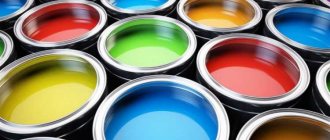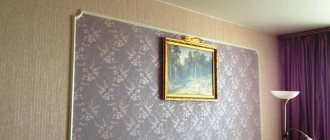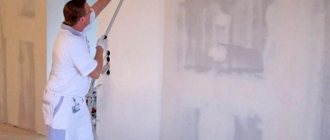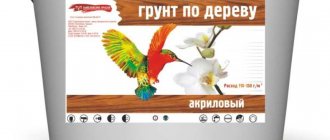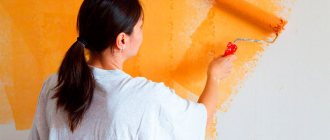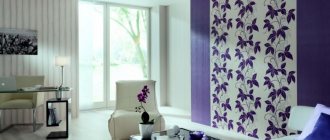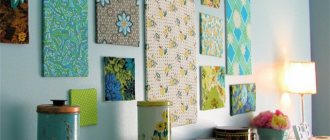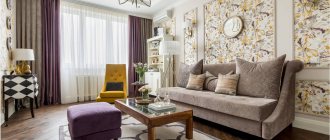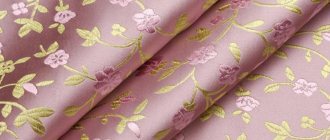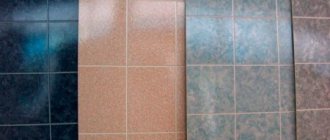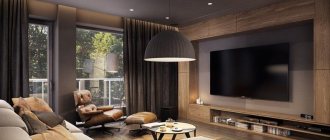Why do you need a primer?
Before initial finishing, the surface must be primed; this will save material consumption and increase its service life. The primer for liquid wallpaper can get into small crevices and pores of the base, which is what ensures easy application to the finishing material.
Thanks to this material:
- dust removal is carried out;
- the foundation becomes strong;
- absorption rates decrease;
- the clutch is made of high quality and durable.
Surface requirements. In order for the finish to be smooth, beautiful, and without flaws, it is worth carefully preparing the surface.
The foundation must have some important requirements:
- there should be no large cracks on it;
- there should be no areas with old coating;
- low moisture absorption;
- high color fastness from development on paint.
Preparation is of particular importance. First, the base needs to be cleaned of old finishing materials. Next, you need to fill the cracks and small irregularities with putty. After this, finishing priming is carried out.
Types of primer
For finishing, it is important to choose a suitable primer solution. Successful coating application depends on this.
Let's look at the main types of primers:
ViewFeatures
| Acrylic universal | They can be used on all substrates without rust (this may come to the surface over time). They are easy to apply and have no odor. Dries within 5 hours |
| Alkyd | Suitable for wood surfaces. They dry within 15 hours. They are not intended for plaster or plaster walls. |
| Acrylic with deep penetration | It is used to prepare putty walls and drywall. Can be used in areas with high humidity |
| Water repellents | They are highly concentrated. Before application, they must be diluted in the proportions specified in the instructions. |
Selecting a primer mixture
To choose a primer for liquid wallpaper, pay attention to the following criteria:
- You shouldn't buy the first thing you see on the counter. It is important to carefully study the type and composition.
- The solution must be intended for liquid trellises.
- To prevent mold from appearing in your apartment, it is better to buy mixtures with an antiseptic effect.
- The packaging should be labeled “deep penetration.” This type will be able to thoroughly prepare the surface for applying wallpaper.
- If white or light-colored wallpaper will be used to decorate the base, it is better to use a white primer. It should be applied in several layers, it will hide all problem areas.
- Please pay attention to the expiration date.
How to use?
To ensure that the process of surface treatment before applying liquid wallpaper does not cause difficulties, you can use a few instructions. Before the work process, prepare a roller, a medium-sized flat brush, gloves, work clothes, and a container for the primer solution.
The work algorithm will be as follows:
- The composition is poured into the prepared container, the dry mixture is diluted according to the instructions on the package.
- Take a construction roller, soak it in the primer solution, squeeze it lightly and roll it over the surface.
- It is necessary to prime, evenly distributing the composition. At the same time, it should not flow along the walls, forming puddles on the floor.
- In hard-to-reach places, use a flat brush: it will allow you to process corners, ceiling and wall joints more accurately, without overusing the solution.
- If the walls do not absorb liquid well, roll the roller several times over the same area, then move on to the next one. In this case, a new portion of liquid is added for each section.
- At the end of the treatment, the tools are thoroughly washed, since if the composition remains, it will become rough, and the brush and roller coat will have to be thrown away.
The second coat of primer is applied only after the first has dried. Do not violate the process technology and rush: this may affect the level of adhesion. After applying the second layer, you should wait a day and only after that start gluing the walls with liquid wallpaper. Dry walls do not stick to the touch.
PVA glue
Designed for treating the base before pasting inexpensive paper wallpaper. Before application, it is necessary to dilute it with water in a ratio of 1:2; to dilute it, acrylic paint can be used in the proportions of 1 part glue, 3 parts paint. After application, this mixture forms a durable film with a transparent structure on the surface.
However, a product based on PVA glue has some negative qualities:
- It is not able to penetrate the internal structure, as a result of which its strength characteristics do not increase.
- Does not have antiseptic or antifungal properties.
- Over time it may crack and turn yellow.
- Under the pressure of finishing materials, it begins to gradually peel off.
Errors when working with material
Basically, errors during priming arise due to non-compliance with the technology for preparing the working solution and preparing the surface. In the first case, more water is often added than the manufacturer recommends. Because of this, the soil acquires a liquid consistency and flows off the wall.
When finishing painted glossy surfaces, the wall must be sanded with sandpaper. This layer does not allow the primer to pass through. Because of this, the wallpaper will run off after applying the protective base.
Rough walls must also be primed. This is explained by the fact that such a base, without prior preparation, will absorb moisture from the wallpaper, as a result of which the finishing material will not be fixed to the base.
Preparing the walls
The main stage of repair and finishing work is preparing the base for applying the primer. High-quality, uniform application of the coating depends on compliance with important conditions.
So, the main rules of preparation include:
- Removing old coating. If this is not done, the material will fall off with the applied liquid coating layer.
- Leveling the surface. All cracks, holes, and deformations must be repaired using putty.
- Cover the base with a primer mixture in 2 or 3 layers. A composition with deep penetration or antibacterial properties is applied at intervals of 4 hours so that the previous layer can dry completely. Before application, the material must be stirred well.
If after applying the primer the surface has an uneven color, then it must be painted or puttied. To do this, you should use white putty or paint. Next, the wall is primed again in two layers, which will increase the strength of the putty to the influence of moisture.
Once the surface has been prepared, you can begin applying the material. This will facilitate the process and improve the quality of the applied coating. Builders recommend using a roller, this can reduce the consumption of the mixture.
Priming painted walls
Before applying the primer mixture to painted walls, it is recommended to inspect their surface. Using a spatula, you should clean the walls of paint; you should definitely remove any swelling, because they will stand out a lot after applying the liquid wallpaper.
After the base is cleared of paint, it should be well leveled. To do this, putty is used; it should be used to repair uneven areas, cracks or holes. Wait a while for the putty to dry, then apply the primer in several layers.
Treatment of concrete and plastered walls
Concrete, plastered walls have a strong absorption of moisture, so it is not recommended to immediately apply a primer to them. First, they need to be treated with putty based on gypsum mixtures. After this, you can prime in several layers.
If the surface has cracks, pits, or crumbles and peels, then it is worth using bonding primers.
Wooden walls
Preparing wooden surfaces takes a little time. They should be thoroughly cleaned of old coatings, uneven surfaces should be removed, and cleaned. After this, the wood should be primed in several layers. This material requires the use of mixtures with antiseptic and antifungal effects. After the primer, you can apply other coatings - water-dispersion paint, wallpaper, and various finishing options.
Tools
To apply the primer you will need a minimum of tools: large and small paint rollers to treat the flat part of the wall, a flat brush for corners, hard-to-reach and curved surfaces. Using a spray bottle will make the job easier and ensure even distribution of the primer layer.
If the working composition needs to be prepared from concentrate, you will need a drill mixer.
You can apply the primer with any of these tools
Expert advice
To make the process of finishing a room with liquid wallpaper easy and successful, you need to take into account the advice of experienced builders.
Important expert advice includes:
- For drywall, it is recommended to use compounds with deep penetration. This can reduce the absorbency of the material.
- It is recommended to align the existing screw heads and joints well and sand them with sandpaper. The caps of the fastening components can be sealed with oil, latex paint or enamel, this will prevent metal corrosion.
- For wooden walls, a primer with waterproofing properties is suitable. It will prevent deformation and fungus formation.
- Uneven tone on wood or painted surfaces may show through wallpaper. For this reason, it is recommended to pre-paint them with white paint or to match the color of the topcoat.
- The choice of primer should be approached carefully, having studied the composition, its service life, type and purpose.
The primer layer creates a strong adhesion of the material, which ensures high-quality and uniform application of the coating. At the same time, do not forget about the base of the surface, because for each material it is worth using a certain type of primer.
Selection of soil for liquid wallpaper
Liquid wallpaper is one of the current materials for wall decoration due to its quality characteristics. In order for the applied coating to be durable and beautiful, you need to properly prepare the surface of the walls.
Primers for liquid wallpaper are available in various types. Without using soil, it is impossible to carry out professional repairs or decoration of the premises.
In order not to get confused by the variety of compositions on sale, you need to study their properties and choose the most suitable option. Let's look at the characteristics of primers and the technology for their application.
Which primer to choose for walls under liquid wallpaper
A primer is required not only to increase the degree of adhesion of the coating to the base. Its main task is to prevent water from entering the structure.
To choose high-quality soil, you need to give preference to a material with a high level of hydrophobicity. The treatment should be carried out in 2-3 layers.
It is important to choose the right type of soil.
It is recommended to apply the following types of primers under liquid wallpaper:
- Acrylic is considered the best option. They are easy to apply, dry quickly and spread evenly.
- Deep-penetrating - perfectly absorbed by the base. After the material dries, a moisture-proof film of high strength is formed. An important advantage is the ability to smooth out the imperfections of the base.
- Quartz - made using quartz dust. The material makes the surface slightly rough. This helps to apply liquid decorative coating more efficiently.
When choosing a material, you need to take into account the type of surface that you plan to finish. Modern manufacturers offer products for certain types of bases and universal mixtures.
What is liquid wallpaper
This material is produced in dry form based on cellulose fibers, pigments and other additives. The wallpaper is packaged in bags whose structure resembles sawdust. Requires dilution with water before application. They form a homogeneous, seamless surface that is resistant to mechanical stress.
In order for liquid wallpaper to adhere tightly and be applied well, it is necessary to prepare the surface and prime it in several layers.
Why do you need a primer?
The primer will improve the adhesion of the walls to the coating
To save material consumption and extend its service life, the wall must be primed before applying the finishing touch. The primer for liquid wallpaper penetrates into the pores and small crevices of the base and makes it easy to apply to the finishing material.
Application of primer promotes:
- removing dust from the surface;
- giving the base strength;
- ensures uniform application of liquid wallpaper;
- reduces the absorbency of the wall;
- better adhesion of materials.
The primer is applied to the prepared, flat surface in several layers. Each subsequent layer is applied after the previous one has dried.
Choosing a primer
- Try to choose a primer from the same manufacturer
- The final result when applying liquid wallpaper depends on the correct choice of primer.
- The main criterion on which we will rely when choosing a composition is the characteristics of the wall.
- The best option is to choose a primer made by one manufacturer with liquid wallpaper.
Let's look at the types of primers and their characteristics in the table:
No. Type of primer Characteristics
| 1 | Acrylic universal | Suitable for application on all types of substrates that do not have rust stains (may bleed through to the surface). Easy to apply, odorless, dry within 5 hours. |
| 2 | Alkyd | They are ideal for coating wooden surfaces. Dries in 15 hours. Not suitable for application on gypsum and plastered walls. |
| 3 | Acrylic deep penetration primer | Helps prepare putty surfaces and drywall for applying liquid wallpaper. Strengthens old, fragile, highly absorbent walls. It can be used in rooms with high humidity. |
| 4 | Water repellents | They are produced in the form of concentrated formulations, which are diluted before application in the proportions specified in the instructions. |
If there is rust, oily or other stains on the surface, they must be removed mechanically (sandwiched with sandpaper) or painted to match the color of the future topcoat. If this is not done, the stains will appear on the surface and ruin the appearance of the wall.
Peculiarities
The primer is a means of preparing the base for further finishing. It is produced in the form of a concentrate or a ready-made composition that does not require adjustment before application to the surface. The concentrated type option is a powder mixture, which must be diluted with water at room temperature before treating the surfaces of walls and ceilings. The amount of water for diluting a specific type of material is indicated on the product packaging. The consistency of the finished composition resembles thick milk.
PVA glue instead of primer
Diluted PVA is good for priming walls
Some people use PVA glue diluted with water in a ratio of 1:2 or with acrylic paint in a ratio of 1:3. This primer forms a film on the wall, allows you to save on purchasing a primer, and is suitable for covering the surface before gluing cheap paper wallpaper.
Disadvantages of primers based on PVA glue:
- does not penetrate into the base, therefore, its strength does not increase;
- does not have antibacterial and antifungal properties;
- over time it cracks and turns yellow;
- Peeling is possible under the weight of finishing materials.
Since liquid wallpaper is an expensive material, you should not skimp on purchasing a high-quality primer.
Features of finishing material
Liquid wallpaper is one of the types of decorative plaster. It is based on silk or cellulose fibers, the latter being a by-product of wood processing. For beauty, manufacturers add various dyes and decorative elements, such as glitter. The third required component is CMC glue, which is often used for gluing paper wallpaper. It is needed in order to connect all the elements together. The final result is very similar to good quality wallpaper, hence the name.
The advantage of the liquid composition is that they can be applied to almost any surface, even if it has an unusual shape. With their help they make interesting accents and think through an unusual design of the space.
There are also disadvantages: the material is quite expensive and requires a carefully prepared surface. Accordingly, you will have to spend money on primer and putty. If the surface is very uneven or poorly processed, the texture will sooner or later become visible.
Preparing the surface for priming
A necessary stage of repair work is high-quality preparation of the walls.
Sequence of preparatory work:
- We remove all flaking, weakly adhering building materials, otherwise they will fall off during use along with the layer of wallpaper.
- We level the surface, fill all cracks, chips, and dents with putty. Liquid wallpaper can only hide small unevenness in the wall.
- We cover the wall with 2 or 3 layers of deep penetration primer or an antiseptic solution. Apply the composition at intervals of 4 hours so that the previous layer has time to dry. Before use, stir the primer thoroughly.
- If after applying the primer we see that the surface is not a uniform color, it needs to be puttyed or painted. We use white putty (paint) or mix it with a color to match the color of the wallpaper.
- Prime the wall again in 2 layers. This will increase the strength and resistance of the putty to moisture present in the liquid wallpaper solution. Watch all the details of surface preparation in this video:
Preparing the base
Preparing the surface for priming is a mandatory stage of finishing work.
We carry out the work in the following sequence:
- We remove the old decorative finish, remove the flaking areas of the plaster.
- We level the walls with a layer of plaster or putty.
- We open up the cracks and seal them with mortar.
- We coat the structures twice with an antiseptic solution to prevent the development of fungus and mold, if these components are not present in the primer you have chosen.
Adviсe
There are several rules that, if followed, will make the job easier and extend the life of the finish coating.
Some tips for preparing walls made of various materials:
- We coat the drywall with a deep penetration compound to reduce the absorbency of the material. Please ensure that the screw heads and joints are properly aligned and smoothed with sandpaper. Fastener caps can be painted with oil, latex paint or enamel to prevent metal corrosion.
- A waterproofing primer is suitable for wooden structures. It will protect the wood from deformation and rotting under the influence of moisture.
- Coating fresh wood with a shellac compound will prevent resin from escaping and hide discolouration.
- The uneven tone of wooden or painted surfaces can show through liquid wallpaper, so it is recommended to pre-paint them with white paint or the color of the finishing layer.
- In stores, sellers often advise purchasing expensive compounds, since they generate a large profit from their sale. You need to study the properties of each material and choose the best option in terms of price-quality ratio. For more information on how to choose a composition for preparing walls, watch this video:
We looked at how to properly prepare walls for applying liquid wallpaper. By following these recommendations, you will get a beautiful surface, make it easier to apply the composition and reduce the consumption of materials.
Primer for liquid wallpaper - why is it needed?
Today, many people choose practical and beautiful liquid wallpaper for decorative finishing of walls and ceilings. They fit perfectly on any surface, forming a seamless fabric. If you are also going to apply this finish yourself, do not forget about preparing the walls, one of the stages of which is priming.
How to avoid possible mistakes?
Treat the plasterboard surface with a deep-impregnating agent to reduce the porosity of the material.
In order to prevent corrosion, the heads of the hardware are painted with a paint of a suitable shade.
Wood is best treated with a waterproofing primer mixture that prevents deformation and rotting. A shellac composition applied to a wood surface will prevent the appearance of resin on it and will hide differences in color shade under its layer.
Requirements for the surface to be finished
In order for walls covered with liquid wallpaper to have a durable surface that is uniform in color and structure, they must be brought into compliance with the following requirements:
- Foundation strength. There should be no large cracks, areas with old wallpaper, peeling plaster or peeling paint;
- Low moisture absorption rate. If the base material has a high water absorption capacity, it will be difficult for you to apply a liquid mixture to it, it will stick worse, and the walls themselves may suffer from excess moisture;
- Color fastness. The color of the walls should not show through the wallpaper. This often occurs when finishing concrete or metal surfaces when they come into contact with a wet working mixture.
For reference. Small irregularities and cracks can be eliminated directly by applying liquid wallpaper, but the material consumption will increase.
Tools and instructions
To properly process the base, you need to prepare the tools for work and become familiar with the procedure for carrying out the work.
To apply the composition you will need:
- paint roller (preferably polyamide with short or medium pile);
- medium sized flat brush. It is recommended to use a tool with synthetic fiber. It has less climbing and is more durable;
- a tray for diluting the primer;
- gloves.
The procedure for surface treatment is as follows:
- the finished composition is poured into the prepared container, the dry mixture is poured out and diluted in accordance with the manufacturer’s instructions;
- the roller is impregnated with the solution, lightly squeezed and begin to roll over the surface, making sure that the primer does not spread, but is absorbed;
- It is recommended to use a brush to treat corners and hard-to-reach places;
- Smooth walls that do not absorb the composition well must be rolled several times in the same place. When moving to the next section, it is necessary to re-wet the roller;
- After finishing work, the roller and brush must be thoroughly rinsed. If you do not do this right away, the composition will harden and the instrument will have to be thrown away.
Important. Applying the second layer must be done only after the first has completely dried. You can tell that the primer has hardened by touch. Fingers do not stick to a dry surface.
Primer selection
When deciding which primer to use for liquid wallpaper, you need to take into account the type of surface to be finished. As a rule, ready-made compounds are purchased that are intended for impregnation and strengthening of bases made of certain materials. Very often there are universal primers that can be used for different surfaces.
Concrete and plastered walls
Before finishing such walls with liquid wallpaper, they must be puttied with a gypsum mixture to fill cracks and pores and level the surface. Before applying the putty, the walls are treated with a deep penetration primer. Next, many inexperienced finishers have a question: why prime an already strong, smooth and fairly light putty surface? The fact is that it is highly absorbent, and liquid wallpaper is a mixture diluted with a large amount of water.
To prevent it from being absorbed by the base, it must be primed, not just once, but two or three times, because the first layer is almost completely absorbed by it. The instructions allow the use of the following types of soil for such walls:
- Acrylic – characterized by the absence of an unpleasant odor and a short period of complete drying;
- Universal – suitable for processing a wide variety of materials with medium and low porosity;
- Special – used in rooms with high air humidity.
You can also use white water-based facade paint with the addition of PVA glue in a 2:1 ratio as a primer.
Note. It has been noticed that sometimes the use of PVA produces yellow spots and streaks on the finished surface. The popular primer Ceresit CT17 suffers from the same drawback.
Plasterboard walls
Their preparation for finishing with liquid wallpaper is carried out similarly to the preparation of concrete walls: first the joints are sealed, then they are primed, puttied and primed again, applying a deep penetration compound twice. This choice of primer is due to the high absorbency of the cardboard surface of the material.
Particular attention should be paid to the places where the drywall is attached to the frame. If the heads of the screws are not deep enough and protrude through the layer of putty, they must be coated with water-insoluble paint - oil, latex or enamel. Otherwise, upon contact with water, metal corrosion will begin, which will give rusty spots on the surface.
Wooden walls
A very important question is what primer to use for liquid wallpaper on walls and partitions made of plywood, chipboard or OSB boards. As you know, wood absorbs moisture well, but at the same time becomes deformed and is at risk of rotting. Therefore, a waterproofing primer is used to treat such substrates. And if the walls are made of “fresh” wood, it is recommended to cover them with shellac primer - it will prevent the appearance of tree resin on the surface and hide knots.
Advice. Before using the primer, treat the wood with antifungal agents.
Since wooden surfaces have a non-uniform color, which can show through liquid wallpaper, it is recommended to paint them with white or light water-based paint after the primer has dried. The price of finishing will increase, but you will be confident in its quality.
Applying primer to various surfaces
Work on priming any bases must be carried out at low humidity and positive temperatures from 5 to 25 degrees.
If the temperature is too high, the primers dry quickly without being able to penetrate to a sufficient depth.
The technology for applying the primer depends on the base material and the choice of primer mixture composition.
When preparing a solution from a dry or concentrated mixture, follow the manufacturer's instructions.
Mix the ready-to-use mixture thoroughly until smooth.
Thorough mixing requires adhesive soil containing quartz filler, which settles to the bottom.
Pour the solution into a paint tray.
We cover the wall with an even layer of primer using a roller or brush, moving sequentially from top to bottom.
Apply the second layer of impregnation after the first has completely dried, but not earlier than after 4 hours. The drying time of a certain composition is indicated on the packaging. You can begin subsequent finishing no earlier than one day later.
Roller priming provides a more uniform layer and allows you to use impregnation more economically.
When treating dark bases or uneven color, it is better to paint the walls with water-based paint in white, or in the color of the decorative finish.
Painted walls
It is better to prime walls painted with water-based compounds with acrylic impregnations.
Surfaces painted with oil paint are treated with adhesive impregnations. They will give the surface roughness and improve the adhesion of the decorative coating to the base.
You must first clean the painted walls with light-grit sandpaper and degrease them.
It is better to apply impregnation with a roller, in two or three layers, following the manufacturer’s recommendations.
If there are unevenness, delamination and paint shedding on the surface, it is better to remove the old coating, re-plaster and putty.
Treatment of concrete and plastered walls
Concrete and plastered bases are impregnated in two approaches with a deep penetration primer, with an interval of at least 4 hours.
If the surface is too porous, peeling and crumbling, it is better to use bonding primers.
We repair base defects, cracks and unevenness with cement or gypsum mortar.
To ensure uniform color and uniform impregnation, we putty the walls with gypsum putty.
Apply two coats of primer evenly using a roller and brush.
You can additionally paint the walls with water-dispersion or acrylic paint.
Plasterboard walls
You can apply liquid wallpaper to drywall after completing all the technological steps:
- surfaces of plasterboard sheets are primed twice to ensure adhesion;
- We fill in uneven spots and grooves from self-tapping screws with putty.
- We glue the joints of the sheets with sickle tape and then putty.
- Perform a continuous putty on the surface of the walls with a thin layer and let it dry.
- Cover the base with two or three layers of primer. In this case, apply the next layer after the previous one has completely dried.
Expert advice
During the repair process, you often have to deal with non-standard situations:
- For example, in private or old city houses, it is not always possible to determine what material the partition is made of or how durable its surface is. In such cases, it is best to apply several layers of universal wallpaper primer.
- If you want to mask with liquid wallpaper any metal elements protruding from the wall - pipes, corners, etc., they must first be treated with an alkyd, phenolic or glyphthalic primer. Although it is quite possible to use enamels or oil paints.
- It is more convenient to apply liquid wallpaper not to a smooth surface, but to a slightly rough one. To make it like this, you can use a special primer with quartz dust or add fine river sand sifted through a flour sieve to the selected composition.
Purpose of the primer
The primer for liquid wallpaper should have the following purpose:
- for leveling surface roughness and unevenness;
- elimination of micropores in concrete and brick;
- savings in liquid finishing consumption;
- improvement of appearance;
- increasing adhesion (adhesion) of the working edge and material;
- strengthening a section of the wall;
- preventing the formation of mold and mildew;
As you can see, the scope of application of the primer mixture before applying liquid wallpaper is wide.
Advantages and disadvantages of application
Before applying liquid wallpaper, the surface must be primed. This is done because the mixtures used in such cases differ in the following features:
- increase the adhesion of liquid wallpaper to the surface;
- reduce the consumption of finishing material;
- form a crystalline mesh, which increases the service life of the wallpaper;
- speed up work on applying liquid wallpaper;
- form a moisture-proof layer;
- prevent destruction of the base;
- eliminate microcracks.
Among the disadvantages of primer mixtures are the following:
- due to increased viscosity, a number of mixtures take longer to dry, therefore increasing the period of finishing work;
- Due to improper preparation of the solution, noticeable stains may appear on the surface of the liquid wallpaper.
See also
Technical characteristics of enamel KO-870, consumption per m2 and application methods
It is recommended to buy primer mixtures of the same brand as liquid wallpaper. In this case, maximum adhesion and protection from negative factors are achieved.
Composition selection
Priming is necessary for strong adhesion of the surfaces of finishing materials and the wall. Therefore, experts disagree on the issue of choosing the composition of the primer mixture. This happens due to the fact that today there are many mixtures suitable for this type of work on the building materials market.
For example, acrylic mixture. It increases the moisture resistance of the surface and improves its appearance. It is applied to the area in an even layer, increases the durability of the front covering, and is odorless. Its components prevent the appearance of mold. Deep penetration soil mixture. Thanks to the presence of active components, the primer penetrates into the pores of the base, binds them and impregnates them. After its application, the surface gains strength and consumes a small amount of water. Concrete contact primer. Unlike a deep penetration mixture, concrete contact is designed to work with dense areas. It creates a rough layer that is aimed at creating high adhesion.
Relevance
Today, primers are presented in a wide range on the construction products market. This material does not relieve walls from serious problems. The primer is applied to the base only after all the cracks have been covered, the bumps have been leveled and visually noticeable pits have been removed. If you ignore this preparatory process, more liquid wallpaper will be lost during gluing, and its application layer will be uneven, which can be visually noticeable.
Using a primer before gluing will not only reliably connect the facing material to the base, it will also simplify the finishing process. It will relieve the ceilings from high absorbency, while gluing will make adjustments easier. The mass of liquid wallpaper will not dry out instantly, which will allow it to be distributed over the wall surface in a dense, uniform layer.
The more penetrating the primer, the better.
Using a primer before pasting wall surfaces with liquid wallpaper reduces the consumption of raw materials. This composition isolates problem areas of planes, for example, with metal reinforcement, so rust stains will not appear on the surface of the finished cladding over time. The layer of film formed after treating the walls with soil will allow you to keep fairly heavy types of liquid wallpaper on the surface. Applying primer to the walls three times will mask and isolate the spotty base.
From the mass of varieties, three categories of primer can be distinguished, which can be purchased for treating walls before covering them with liquid wallpaper:
- acrylic;
- universal;
- special (concrete contact type).
A good primer can smooth out minor imperfections in the wall for finishing. The acrylic variety is quite popular. This primer has good viscosity, the film formed on the surface after drying is quite strong. This primer dries optimally quickly, does not emit an unpleasant odor during operation, and is suitable for interior work. When dried, it forms a polymer crystal lattice on the surface, providing a sufficient level of adhesion.
The universal analogue is notable for the fact that it takes a little from each variety. Therefore, such a primer has penetrating, strengthening and leveling abilities. However, its effect is not as pronounced as that of individual categories. Its penetrating ability is less: such soil penetrates into the thickness of the base by no more than 0.5 cm.
The best choice for preparing the surface of walls for gluing with liquid wallpaper is a primer for concrete contact. Its distinctive feature is the presence of quartz sand in the mixture, due to which, when drying, the surface acquires some roughness. This fact ensures maximum adhesion of liquid wallpaper to the treated surface. This feature is explained by the fact that a too smooth base complicates the pasting process (liquid wallpaper is less well distributed over the surface and can roll off). The presence of roughness on the wall delays the adhesive mass, so it is much easier to lay out the desired pattern from a material of different colors.
